

Trigonometry for Game Programming: Part 1/2. Learn Trigonometry for game programming!
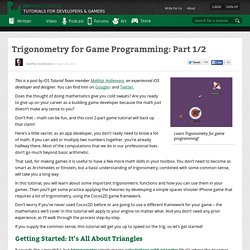
This is a post by iOS Tutorial Team member Matthijs Hollemans, an experienced iOS developer and designer. A Layman’s Guide to Projection in Videogames « Significant Bits. Oftentimes when a videogame has a skewed, overhead point of view, we call it isometric.
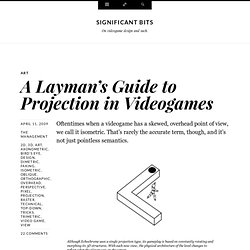
That’s rarely the accurate term, though, and it’s not just pointless semantics. Although Echochrome uses a single projection type, its gameplay is based on constantly rotating and morphing its 3D structures. With each new view, the physical architecture of the level changes to reflect what the player sees on the screen. Projection basically means taking a three dimensional object and displaying it on a 2D plane (i.e., a screen). The Indies' Guide to Game Making. This article originally appeared in issue 246 of PC Gamer UK.
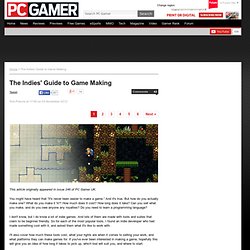
40+ Fantastic Game Development Tutorials From Across the Web. Humus. A Dictionary of Video Game Theory. Preface This dictionary of video game theory is a companion to my book, Half-Real.

With the dictionary, I hope to provide a resource for students, researchers, teachers, and game players looking for terminological clarifications and pointers to further reading. Dev diary number seventeen : Bitwise Tilemapping ‹ Sauropod Studio. Woah.
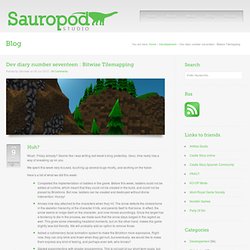
Friday already? Seems like I was writing last week’s blog yesterday. Geez, time really has a way of sneaking up on you. We spent this week very focused, touching up several bugs mostly, and working on the trailer. WebGL: How It Works. This is a continuation from WebGL Fundamentals.
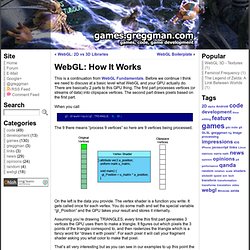
Before we continue I think we need to discuss at a basic level what WebGL and your GPU actually do. There are basically 2 parts to this GPU thing. The first part processes vertices (or streams of data) into clipspace vertices. The second part draws pixels based on the first part. When you call. Making Shadow Complex: Donald Mustard Speaks. Though it's quickly proving to be one of the biggest buzz games of 2009, Shadow Complex was not a sure bet for Chair Entertainment when the project began.

Born of a love of Super Metroid and G.I. Joe, the exploratory side-scroller meshes classic '90s 2D game design with contemporary technology, visuals, and combat. Chair Entertainment was founded out of the ashes of the Advent Rising project, an ambitious but ultimately unsuccessful Majesco-published attempt to build a triple-A epic fantasy adventure series around the writings of sci-fi author Orson Scott Card. Chair's mission is now decidedly different: to create high-quality download-only games. Build a Classic Pong Game From Scratch. In this screencast tutorial, I'll show you how to use Construct 2 to make a basic Pong game that can be played either against another person or against a simple computer AI.

No previous programming or game development experience is required -- all you need is a copy of Construct 2 (which has a free edition). Introduction The game we'll build here is a pretty basic version of Pong that allows you to either play versus a human player on the same computer or against a very basic AI. You can play the finished demo here. You probably know how Pong works, but just in case: The two paddles are controlled either by the CPU, the arrow keys, or the S and X keys.There is a constantly moving ball that rebounds on walls on top and bottom of the game field.Each time the ball goes beyond a player's paddle, their opponent scores a point.The first player to 10 is considered the winner.
Also, pressing P pauses the game. Fragment Shader to Simulate Water Surface in LibGdx. In this tutorial we would simulate foreground water similar to the ones we see in many platformers.

This shader is written in OpenGL Shading Language, so they can be applied in all environments using OpenGL for rendering and for DirectX it has be changed a bit but basic concept would remain the same. Game Bytes #3. Game Programming Patterns / Design Patterns Revisited / Singleton. WebGL Essentials: Part I. WebGL is an in-browser 3D renderer based on OpenGL, which lets you display your 3D content directly into an HTML5 page.
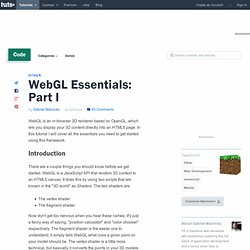
In this tutorial I will cover all the essentials you need to get started using this framework. Introduction There are a couple things you should know before we get started. WebGL is a JavaScript API that renders 3D content to an HTML5 canvas. It does this by using two scripts that are known in the "3D world" as Shaders. The vertex shader The fragment shader. OpenGL ES 2.0 for iOS, Chapter 1 - Introduction. It is not an exaggeration to say that the iPhone SDK and the App Store have forever changed the way that mobile applications are developed and sold.
By building the iPhone SDK on the foundation laid by NeXT with NextSTEP, which later became Apple's Cocoa framework for developing desktop applications, Apple was able to provide third-party developers of their new mobile platform with tools and some APIs that already had the benefit of over 20 years of use, testing, and documentation. Although iOS, of course, contains a great amount of new code designed specifically to handle the needs of a touch-based, mobile computing platform, many of the classes that implement fundamental behavior in the iOS SDK have been in regular use since the late 1980s; that code is extraordinarily robust and thoroughly documented.
Yet if you go looking for specific beginner-level information about how to use OpenGL ES on the iPhone, it can be hard to find. What is OpenGL. Before we can begin looking into writing an OpenGL application, we must first know what it is that we are writing. What exactly is OpenGL? OpenGL is usually thought of as an Application Programming Interface (API). The OpenGL API has been exposed to a number of languages. But the one that they all ultimately use at their lowest level is the C API. OpenGL Transformation. Related Topics: OpenGL Pipeline, OpenGL Projection Matrix, OpenGL Matrix ClassDownload: matrixModelView.zip, matrixProjection.zip Overview Geometric data such as vertex positions and normal vectors are transformed via Vertex Operation and Primitive Assembly operation in OpenGL pipeline before raterization process. OpenGL vertex transformation Object Coordinates. An intro to modern OpenGL. Chapter 2.2: Shaders.
An intro to modern OpenGL. Chapter 2.2: Shaders updated April 5, 2010 17:29:36 PDT « Chapter 2.1 | Table of Contents | Chapter 2.3 » Buffers and textures contain the raw materials for an OpenGL program, but without shaders, they are inert lumps of bytes. If you recall from our overview of the graphics pipeline, rendering requires a vertex shader, which maps our vertices into screen space, and a fragment shader, which colors in the rasterized fragments of the resulting triangles. The vertex shader.
Jump into Game Development with the Tower Defense Genre - Dave Bost. A common dream of most developers is to develop a game. Conjecture abc. Un article de Wikipédia, l'encyclopédie libre. La conjecture abc ou conjecture d'Oesterlé-Masser est une conjecture en théorie des nombres. Elle a été formulée pour la première fois par Joseph Oesterlé (1988) et David Masser (1985). Elle est formulée en termes de trois nombres entiers positifs, a, b et c (d'où son nom), qui n'ont aucun facteur commun et satisfont. Les transformations - Bibliothèques - OpenGL.
A Javascript library that makes working with the HTML5 Canvas element easy. Recent Updates Follow @CreateJS November 2014 Updates in preparation for next release (coming soon).New class model, with big performance increases October 2014 Lots of bug fixes and pull requests.New 'Extras' folder in GitHub with useful tools and classes July 2014 Major overhaul of Graphics to include a useful command pattern, and a big performance increase.Added Graphics.store() / unstore()
HTML5 2D game development: Introducing Snail Bait. The great thing about software development is that, within reason, you can make anything you can imagine come to life on screen. The OpenGL Programming Guide. Higher-Order Fun. Last time, we introduced vectors, and hopefully that introduction alone would be compelling reason to use vectors where it makes sense to. This time, we’ll discuss common operations associated with vectors, and their many uses.
All of these operations are commonly found in vector operation libraries. Length. Graphics and Rendering. Preface: What is OpenGL? On the most fundamental level, OpenGL is a software interface that allows a programmer to communicate with graphics hardware. An intro to modern OpenGL. Chapter 1: The Graphics Pipeline.